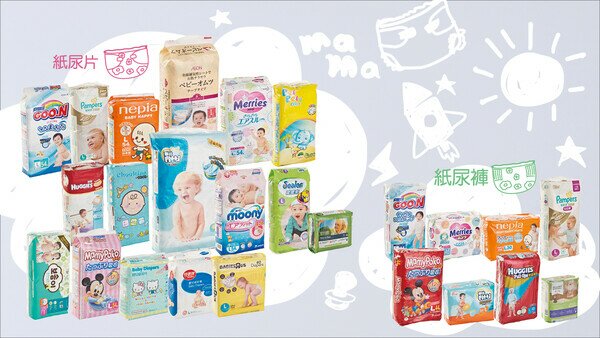Estimation from overseas showed that a young child would use approximately 6,000 diapers before they turn 2.5-year-old. Before quitting diapers, a young child uses thousands of disposable diapers, creating a large amount of waste hardly decomposable, which will evolve into an environmental issue. "Every bit counts", selecting both economic and environmentally friendly diapers/training pants has become an important issue for parents. Some consumers may consider opting for reusable cloth diapers. The Consumer Council recommended that parents to use disposable and cloth diapers for babies in turns to support sustainable consumption.
The Consumer Council tested 17 models of diapers and 8 models of training pants. From the test findings, water vapour breathability (25%), water absorption ratio (20%), surface dryness (20%), leakage volume (25%) and adhesive tape efficiency (10%), on a 5-point scale, all samples performed well in their water absorption and leakage tests with more than half of the samples awarded an overall score of 4.5 points. No allergy inducing substances, such as formaldehyde and migratable fluorescent substances, were detected and all the samples were in compliance with the hygiene standards.
The prices of the diapers samples ranged from $1.3 to $8.1 per piece, making a difference of over 5 times. If a baby used 6 diapers per day, the difference in monthly expenditure between the most and the least expensive models would be more than $1,200. 1 model with an overall rating of 4.5 points is $1.5 per piece on average, its performance has surpassed the model priced at $8.1 per piece. It shows that there is no linkage between quality and price. Pants are priced from $2.3 to $8.7 per piece, making a price difference of nearly 3-fold.
The main functions of diapers / pants are to absorb moisture and prevent leakage. In the test of water absorption ratio, performance varied notably among the samples. 1 model attained the highest score of 4.5 points, 13 models scored only 2.5 points, with another 2 models scoring ever lower 2 points. In the leakage test, 1 sample had liquid passing through its backsheet when pressure was applied, hence was given 2.5 points while no leakage was detected in the remaining samples and all were awarded with 5 points.
Although the products need to be leak-proof, they must also be breathable, in order to avoid irritations of the skin after the baby sweats or excretes, resulting in rash or skin allergy. In the water vapour breathability test, 19 models scored 4 points or above, with 2 awarded the highest score of 5 points. However, there were 2 models of disposable diapers and 1 pants scored 2 points only.
Low air permeability of cloth and/or disposable diapers/pants would create a humid environment for bacteria to multiply easily. Because of babies' tender skin, if baby's skin is exposed to prolonged contact with urine, or irritated by abrasions, symptoms of diaper dermatitis including rash or itchiness will appear. If diapers are soiled with faeces, bacteria can access the urinary tract and bladder resulting in urinary tract infection and cystitis (inflammation of the bladder).
In terms of surface dryness, the overall performance of pants is quite good with 7 models scoring 5 points, and the remaining 1 model scoring 4 points. For diapers, 8 models scored 5 points with 1 model scoring only 2.5 points. The performance of adhesive tape fasteners varied significantly in diapers while for the pants, 7 models provided elastic bands for size adjustment purposes instead of adhesive tapes.
Disposable diapers are composed of non-woven fabrics, plastics, paper pulp and superabsorbent polymers. Different materials can hardly be decomposed after use and have occupied a lot of landfill space. An alternative option available in the market is cloth diapers. In addition to their water vapour breathability, air permeability, waterproofness, and anti-leakage features, cloth diapers are washable and re-usable, hence consume fewer resources than disposable diapers. Some cloth diapers are adjustable to fit babies' waist and hip sizes, which extends usable time of the product.
A life-cycle assessment report on cloth and disposable diapers from the United Kingdom pointed out that, if consumers air dry cloth diapers and use less tumble dryers, use a washer with higher energy-efficiency, wash a full-load in water less than 60°C, then the environmental impact of using cloth diapers will be 40% less than using disposable diapers. Parents can use both types in turns, i.e. use disposable diapers when going out, and use more frequently cloth ones at home, to meet the need of both environmental protection and convenience.
In addition, parents may also be concerned if the diapers contain any substances that are harmful to their babies. Results from studies and tests of diapers in overseas in recent years showed that only trace amounts or no chemical substance harmful to babies' health, such as organotin compounds, PAHs, or azo dyes, were found in diapers.
When buying and changing diapers/training pants for their babies, parents are advised to take note of the following suggestions:
- Poorly fitted diapers may cause abrasions on baby's skin and induce diaper dermatitis;
- The designs and sizes may vary depending on the brands. For first trial, small packages should be purchased. Settle on the right model after comparison;
- Wet or dirty diapers should be changed as soon as possible. Baby buttocks should always be kept dry to prevent diaper dermatitis or urinary tract infection;
- After cleansing or bathing, use a towel to pat dry baby's skin before applying barrier cream.




